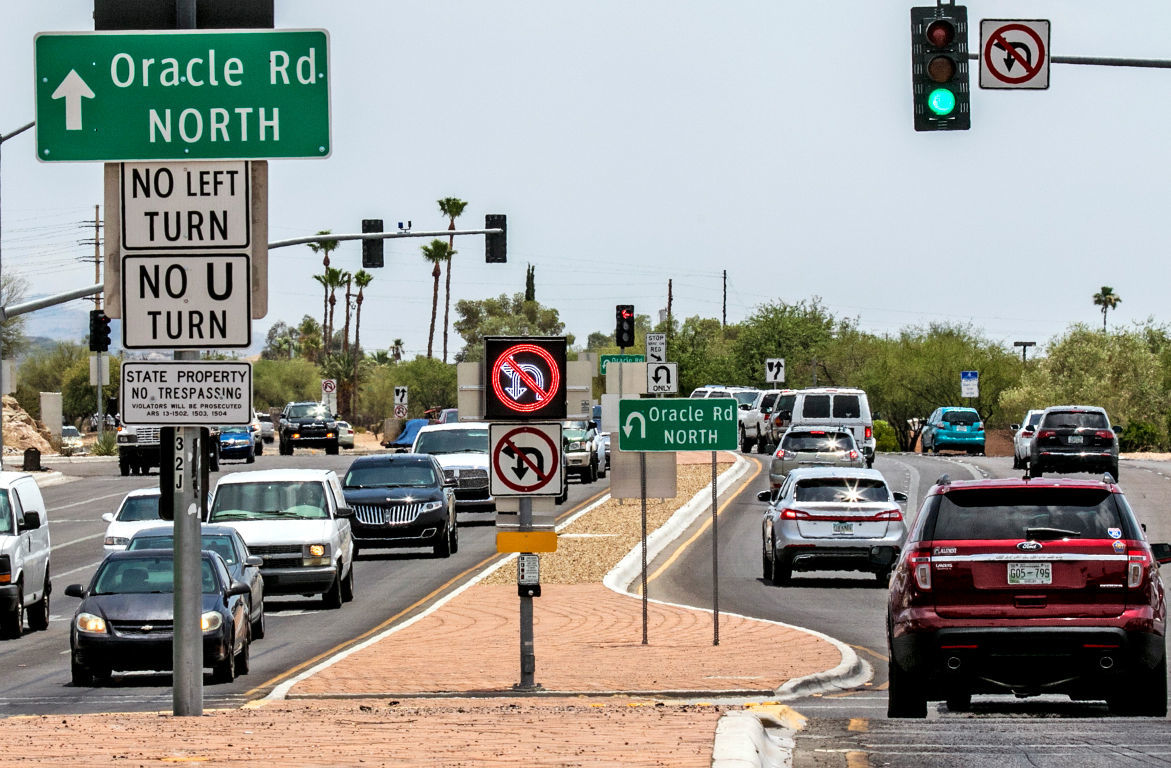Tucson drivers have had almost three years to get acquainted with a traffic innovation known as the “Michigan left.”
Also known as indirect lefts, the novel intersections do not allow drivers to immediately turn left from thoroughfares onto intersecting streets. Rather, they direct those drivers through the intersection and onto U-turn lanes that send them back the other way for a right turn. And yes, they were developed and are widely used in Michigan.
There are two big ideas behind them: cutting down on both the time left-turners take away from other traffic movements and vehicle collisions, benefits with data to back them up (though the local story is a little more complicated thus far).
There are probably traffic engineers that could explain Michigan lefts more succinctly and eloquently, but a traffic engineer this columnist is not.
Pima County has two of these intersections currently: one at Ina and Oracle roads that came online in the fall of 2013 and cost about $5 million, and another at Grant and Oracle roads that was finished shortly thereafter. After the first debuted, the Star asked readers what they thought about the concept in action, and the response was overwhelmingly negative (roughly 80 percent of 425 respondents in an unscientific online poll gave it a thumbs down).
(There’s another online survey accompanying this column, and we’d like to see if attitudes have shifted at all since our last one).
Two more such intersections are slated to be built along Grant over the next year, at Stone and First avenues. And a larger roadway project with similar functions is planned at Valencia and Kolb roads, the Regional Transportation Authority’s Jim DeGrood told Road Runner last week. There are also plans to install several more along Grant as the six-phase, RTA-funded improvement project proceeds.
This reporter’s own unscientific and much smaller survey of motorists and restaurant-goers near the Grant-Oracle Michigan left on Thursday found several enthusiastic supporters; two people at nearby businesses who reported little, if any, impact on their operations; and one critic whose tune changed slightly when the logic of the intersections was explained imperfectly, but hopefully accurately, by yours truly.
“Hey, if it means less accidents, and it’s a proven fact that it helps, let it be,” Benjamin Salcido said after finishing up a lunch at El Guero Canelo, just north of the intersection. However, his immediate reaction to the intersection he drives through regularly was that it was a complicated solution to a non-problem.
A few tables over, Kitty Harris said she’s gotten used to the intersections and thinks they’re an effective way to cut down on crashes, points that drew nods of agreement from her less-talkative lunch companion.
An El Guero Canelo supervisor, Ismael Moreno, said the somewhat-more-complicated route those eastbound on Grant have to take to get to his restaurant has not impacted business, a point echoed by Michelle Frazier, co-owner of the Cafe Marcel creperie just south of the intersection.
“I’ve had some people come from the east who find it really annoying. But has it inhibited business? No,” Frazier said.
Chris Fanelli, the owner of Sausage Deli near the intersection of First Avenue and Grant, said he’s looking forward to the increased exposure for his business that may come as the east-west thoroughfare’s capacity grows. However, he also said the Michigan left set to be built in front of his shop could compromise one of the entrances. But however many entrances there are, his customer base will find a way to get to the business, he said.
“If people like it enough, they’ll come back and plan their lunch,” he added.
The Michigan Department of Transportation, which oversees hundreds of the intersections, points to studies that show sizable drops in wrecks and improved traffic flows, as does the local RTA in its public presentations on upcoming plans.
A handout on the Grant improvement plan touts a 42 percent decrease in signal wait times and a 30 percent decrease in injury crashes after Michigan lefts are installed.
However, DeGrood told the Star there was a slight, “statistically insignificant” uptick in wrecks at the Ina-Oracle intersection over 2014, which he chalked up to the novelty of the design and wrecks at the entrance to Casas Adobes Plaza. Since then, adjustments have been made, and the turn into the shopping center “now basically has a dedicated light,” he said.
Where there was unambiguous improvement, he said, was in north-south travel on Oracle, now unimpeded by those turning left from Ina.
“There is no time dedicated to left-turn phases at Ina,” he added. “All that time was redistributed to other movements.”
“There’s only 60 seconds in a minute, and the more of that time you give to left turns the less time you give to the heavier traffic movements,” he said earlier in the conversation.
With the lessons learned at the first two Michigan lefts, as well as motorists’ growing familiarity with the concept, DeGrood said he expects the coming intersections to be designed better and be received better by the public. The traffic impacts of the soon-to-come Michigan lefts on Grant will also be closely studied, he added.
“I’m not hearing the doubts now,” DeGrood said. “I heard doubts going into it, doubts that it would really improve things.”
If you don't see the one-question survey about Michigan lefts, click here to answer the survey.





